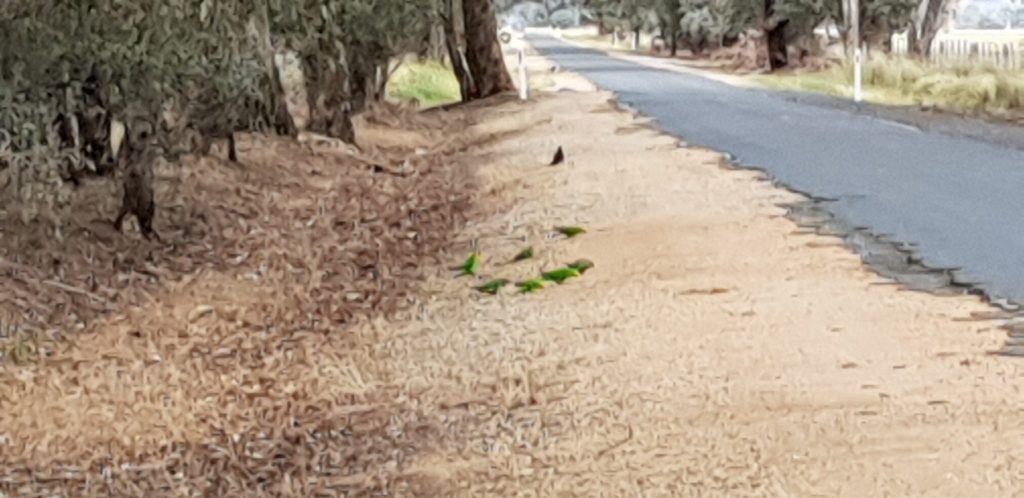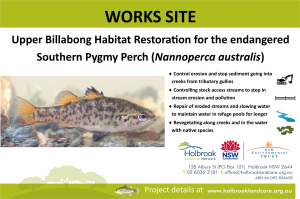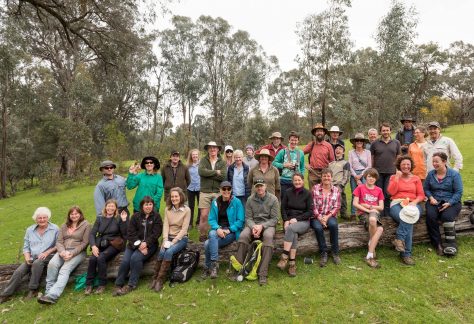
This page has some of the biodiversity information and resources for the Holbrook region, as well as information about current projects
In 2014 we were able to get support from the Wettenhall Trust to assist in the production of the information on this page and raise awareness about the biodiversity values and wildlife of the Eastern Billabong and Upper Murray.
Biodiversity ID Guides and Brochures
Terrestrial Mammals
Pollinators Insects
Birds
Holbrook area has lots of places you can go and see birds, including many threatened species.
At the northern end of town is the Pony Club TSR reserve with its Yellow Box Grassy Woodland environment. Superb parrots can often be seen here. Out the western side of Holbrook (access behind the cemetery or from Enterprise Drive) is the Holbrook Town Common which has been reserved for conservation. Superb Parrots and the Grey Crowned Babbler are regular visitors
In town is the Ian Geddes Bush reserve – in the summer time Kingfishers and Dollar Birds are a common occurrence
Click here to download a Holbrook-Bird-List
Holbrook Bird List


Frogs
Other frogs potentially occurring in the Holbrook area
Sloane’s Froglet – Crinia sloanei
Bibron’s Toadlet – Uperoleia bibronii
Smooth Toadlet – Uperoleia laevigata
Wrinkled Toadlet – Uperoleia rugosa
Booroolong Frog – Litoria booroolongensis
Green Tree Frog – Litoria caerula
Brown Tree Frog – Litoria ewingii
Southern Bell Frog – Litoria raniformis
Verreaux’s Tree Frog – Litoria verreauxii
Common frog species in the Holbrook area
Plains Froglet – Crinia parinsignifera
Common Eastern Froglet – Crinia signifera
Spotted Marsh Frog – Limnodynastes tasmaniensis
Striped Marsh Frog – Limnodynastes peroni
Eastern Banjo Frog – Limnodynastes dumerilli
Giant Banjo Frog – Limnodynastes interioris
Painted Burrowing Frog – Neobatrachus sudelli
Broad palmed Frog – Litoria latopalmato
Peron’s Tree Frog – Litoria peroni
Frogs of the Holbrook Region
Mammals
Terrestrial Mammals ID Guide
Unfortunately here in the Southwest Slopes we lost many of our small ground dwelling mammals to hunting, foxes, land clearing and agriculture not long after first settlement. Yellow-footed Antechinus are still to be found in our grassy woodlands in places and the Agile Antechinus is still common in the Dry Sclerophyll Forests remnants east of the Hume Highway.
Our arboreal mammals have fared better with Brush tailed Possums, Ring Tailed Possums and Squirrel Gliders still common in the Holbrook area. East of the Hume Highway Sugar Gliders, Feather-tailed Gliders and Greater Gliders are also found, adding to the more common species. Around Tumbarumba, Yellow-bellied Gliders are also found.
Holbrook Landcare has Trail Camera for loan to members – contact the office on 02 6036 3181.
Pest animals are unfortunately very common – foxes are probably the most abundant predator on many of our smaller mammals.

Platypus are not often found around Holbrook, but they are still found in many streams of the Upper Murray . It is common however to see Rakali (Water Rats) in the Billabong and larger farm dams. We would love to hear about any sightings of Platypus and Rakali!
Reptiles
REPTILE HABITATS
Riparian areas – border between a waterway and the land, also characterised by the bank of rivers, creeks and streams
Species: Eastern Snake-necked Turtle, Red-belled Black Snake, Inland Carpet Python
Fallen timber
Species: Jacky Lizard, Eastern Bearded Dragon, Olive Legless Lizard, Southern Rainbow Skink, Ragged Snake-eyed Skink, Large Striped Skink, Cunningham’s Skink, Three-toed Earless Skink, Delicate Skink, Garden Skink, Boulenger’s Skink, Dwyer’s Snake, Eastern Blue tongue, Woodland Blind Snake, Blackish Blind Snake
Remnant woodlands – small patches of existing bushland in the landscape
Species: Jacky Lizard, Lace Monitor, Inland Carpet Python
Native grasslands
Species: Pink-tailed Worm-lizard, Olive Legless Lizard, Large Stiped Skink, Dwarf Skink, Eastern Blue-tongue, Eastern Brown Snake
Leaf litter
Species: Southern Rainbow Skink, Delicate Skink, Garden Skink, Dwarf Skink
Surface rocks
Species: Pink-tailed Worm-lizard, Eastern Stone Gecko, Copper-tailed Skink, South-eastern Slider, Boulenger’s Skink, Dwyer’s Snake, Woodland Blind Snake, Blackish Blind Snake
Rocky outcrops – a rock formation that is above the surface of the surrounding land
Species: Southern Marbled Gecko, Ragged Snake-eyed Skink, Cunningham’s Skink, Tree Skink, Inland Carpet Python
Large trees or hollow-bearing trees
Species: Southern Marbled Gecko, Ragged Snake-eyed Skink, Tree Skink, Lace Monitor, Inland Carpet Python
The key recommendations to improving reptile habitat are:
- Fence out rocky outcrops from livestock to protect exfoliated rock, prevent soil erosion and overgrazing
- Modify grazing regimes to improve native ground cover to improve connectivity and tussock habitat
- Avoid cleaning up fallen timber to maintain shelter, foraging and nesting places
- Avoid cleaning up bush rock to maintain shelter, foraging and nesting sites
- Protect isolated paddock trees to maintain habitat for arboreal (tree) geckos
HOLBROOK REGIONAL REPTILE SPECIES LIST
Species |
Eastern Snake-necked Turtle (Chelodina longicollis) |
Jacky Lizard (Amphibolurus muricatus) |
Eastern Bearded Dragon (Pogona barbata) |
Pink-tailed Worm-lizard (Aprasia parapulchella) |
Olive Legless Lizard (Delma inornata) |
Southern Marbled Gecko (Christinus marmoratus) |
Eastern Stone Gecko (Diplodactylus vittatus) |
Southern Rainbow Skink (Carlia tetradactyla) |
Ragged Snake-eyed Skink (Cryptoblepharus pannosus) |
Large Striped Skink (Ctenotus robustus) |
Copper-tailed Skink (Ctenotus taeniolatus) |
Cunningham’s Skink (Egernia cunninghami) |
Tree Skink (Egernia striolata) |
Three-toed Earless Skink (Hermiergis talbingoensis) |
Delicate Skink (Lampropholis delicata) |
Garden Skink (Lampropholis guichenoti) |
South-eastern Slider (Lerista bougainvilii) |
Dwarf Skink (Menetia greyii) |
Boulenger’s Skink (Morethia boulengeri) |
Eastern Blue-tongue (Tiliqua scincoides) |
Dwyer’s Snake (Parasuta dwyeri) |
Eastern Brown Snake (Pseudonaja textilis) |
Red-bellied Black Snake (Pseudechis porphyriacus) |
Woodland Blind Snake (Ramphotyphlops proximus) |
Blackish Blind Snake (Ramphotyphlops nigrescens) |
Lace Monitor (Varanus varius) |
Inland Carpet Python (Morelia spilota metcalfei) |
Fish
Southern Pygmy Perch Recovery
(Note this content in progress)
The Upper Billabong creek catchments experienced a one-in-one hundred year flood event in 2010. After the floods, landholders reported seeing many native fish that they had not seen before. NSW DPI Fisheries had done drought refuge surveys the year before and detected an endangered Southern Pygmy Perch (Nannoperca australis) in the Little Billabong Creek near Yarra Yarra Ck junction. This lead to more extensive monitoring which found populations of this fish in several creeks in the Upper Billabong (Wantagong Valley), Woomargama Ck and the Coppabella Ck at Jingellic.

Holbrook Landcare has been working to:
- Reduce erosion in these catchments to protect stream water quality and refuge habitats
- Create and maintain instream refuge habitats for fish
- Continue to encourage fencing and revegetation to control grazing in these systems

Links to reports:
- Wantagong Ck Project
- Woomargama Station Project
- Ten Mile Ck project
Vegetation Types
We are lucky to be in the southwest slopes bioregion of NSW . To the west of the Great Dividing Range, the dominant vegetation is the Grassy Box Woodlands – an endangered ecological community in NSW and nation-wide. To the east we have the foothills of the Great Dividing Range and the transition from western slopes Woodlands Woodlands up to the dry and wet sclerophyll forests.

Grassy Woodlands (dominated by the Yellow Box, Grey Box, Redgum and White Box species) occur in the fertile farming landscapes. Sadly, the Grassy Woodlands are around 95% cleared and few good quality remnants remain. Holbrook Landcare has focused on protecting those remnants that do exist and undertaking revegetation to increase the amount in the landscape.

In the foothills, the dry sclerophyll forests are better protected in National Parks and reserves because they are on the less productive lands. They are however impacted from past grazing, harvesting and changed fire regimes and are not pristine areas.

Slopes2Summit Partnership - Connectivity and Landscape Partnership
The Slopes to Summit (S2S) Partnership is group of organizations and agencies that share information and resources aims to improve landscape scale connectivity, functionality and resilience of native ecosystems within a 200-2200m altitudinal gradient, from the box gum woodlands of the South West Slopes bioregion north of Albury to the foothill forests of Kosciusko NP.
We are a regional Partnership of the Great Eastern Ranges Initiative (read more on the Great Eastern Ranges website)
The S2S Partnership has been successful in many on ground projects delivered through the partners that contribute to the aims of the organization.
Slopes2Summit Partnership

Slopes2Summit Bush Connect funded by NSW Environmental Trust
Short video from the Slate To Plate Bushwalk in October 2016 – celebrating connectivity conservation in the Slopes2Summit Partnership area.
Current and Past Biodiversity Projects
Birds on Farms – Saving the Nectar lovers 2019-2021

Our high-production farming landscapes are not only productive for pastures and crops – the grassy woodlands that used to grow on them were also the key foraging habitat for many migratory honeyeaters and parrots. The big old Yellow Box, Red-gum, White Box and Grey Box trees growing in the deep, fertile soils of the southwest slopes are the “refuelling” stops for these species on their way to larger remnant areas of Ironbark and coastal resources.
In a new project partnership with the NSW Saving our Species (SOS) Program and Foundation for National Parks and Wildlife (FNPWS) we have joined with BirdLife Australia to establish some Birds on Farms (http://birdlife.org.au/documents/OTHPUB-BirdsOnFarms.pdf) monitoring sites across our area to gain a better understanding of how, what, and when they are using as resources here, and undertake some on-ground plantings for the Nectar-lovers.
Focus species for us are the Little Lorikeet, Black Chinned Honeyeaters and the Dusky Woodswallow.
Project Officer Ben Humphries is with BirdLife based in Albury – he has come down with his family from 20 years in the Top End as a bird and eco-guide. He will be looking for farms & volunteers to establish some monitoring sites in the new year – surveys are done 4 times a year and contribute to Birdlife Australia’s database of birds across Australia. This is an important scientific resource that informs us about how our bird populations are going over time and how they use the landscape.
Grassy woodlands Restoration 2019-current
Grassy woodlands is a partnership project with the Murray Local Land Services and is a revegetation and restoration for Grassy Box Woodlands. It is jointly delivered by Holbrook landcare, West Hume Landcare and Corowa Landcare.
The guidelines and information can be found here
Slopes2Summit BushConnect 2016-current
The Slopes2Summit (S2S) BushConnect project, supported by the NSW Environmental Trust, has opportunities for farmers in two priority local landscapes
- Woomargama – Woomargama National Park to Tabletop/Benambra Nature Reserve
- Holbrook Landscape Morgans ridge to the Billabong creek
- Holbrook – Morgans Ridge to Nest Hill Nature Reserve
In the past 5 years we have achieved over 200 ha of on-farm revegetation and remnant protection in priority areas that have contributed to the landscape connectivity.


S2S Bushlinks 2012-2017

The project has worked with over 90 landholders in the S2S region to undertake on-ground activities at 189 sites to protect and increase vegetation in the region. Just over 1220ha of vegetation was protected and restored with final work to be completed in May 2017. This Biodiversity Fund project, funded by the Australian Government, has invested $1.4 million dollars in fencing and revegetation on farms in the region over 5 years, which has been matched by landholder contributions.
The outcomes for biodiversity in the regions are an increase in vegetation cover of 1200 ha and an improvement of connectivity for some species in local landscapes. The next six months will analyse data collected and revisit all sites to assess the condition change and the potential impact on species.

Research Links
Our links with science is so important to make sure we are using the best information to get the best biodiversity outcomes.
The Southwest Slopes Study by the Australian National University Fenner School is a long term monitoring project that informs our actions. Read more about it here
The ANU Sustainable Farms Initiative has grown from this monitoring concept and is a key science partner for us.
Charles Sturt University Institute of Land, Water and Society is also a key partner – involved in the Slopes2Summit Partnership and has strong regional research-practice links.
Citizen Science Tools and Links
There is never enough funding or enough resources to collect all the information we need to inform how we manage our landscapes and wildlife. In the digital age, citizen Science Tools have proliferated. Making these tools available, so that the public can contribute information to scientists is the way of the future. By using some of the tools available, we can compile a large amount of information and if there is control over the quality of the information through apps and other tools, scientist can use it in their studies.
We would encourage people to explore the options but some key ones that help HLN are:
